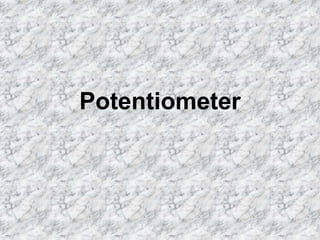
POTENTIOMETER
- 2. Potentiometer • Potentiometer is used for the accurate measurement of potential differences, current and resistances. • It consists of ten meter long uniform wire of manganin or constantan stretched in parallel rows each of 1 meter length, on a wooden board. • The two free ends A and B are brought to the same side and fixed to copper strips with binding screws. • A meter scale is fixed parallel to the wire. A jockey is provided for making contact.
- 3. • A steady current is maintained across the wire CD by a battery Bt. • The battery, key and the potentiometer wire are connected in series forms the primary circuit. • The positive terminal of a primary cell of emf ξ is connected to the point C and negative terminal is connected to the jockey through a galvanometer G and a high resistance HR. • This forms the secondary circuit
- 5. • Let contact be made at any point J on the wire by jockey. • If the potential difference across CJ is equal to the emf of the cell ξ then no current will flow through the galvanometer and it will show zero deflection. • CJ is the balancing length l. • The potential difference across CJ is equal to Irl where I is the current flowing through the wire and r is the resistance per unit length of the wire.
- 6. • Since I and r are constants, ξ ∝ l. • The emf of the cell is directly proportional to the balancing length
- 7. Comparison of emf of two cells with a potentiometer • Potentiometer wire CD is connected to a battery Bt and a key K in series. • This is the primary circuit. • The end C of the wire is connected to the terminal M of a DPDT (Double Pole Double Throw) switch and the other terminal N is connected to a jockey through a galvanometer G and a high resistance HR. • The cells whose emf ξ1 and ξ2 to be compared are connected to the terminals M1,N1 and M2,N2 of the DPDT switch. The positive terminals of Bt, ξ1 and ξ2 should be connected to the same end C.
- 9. • The DPDT switch is pressed towards M1, N1 so that cell ξ1 is included in the secondary circuit and the balancing length l1 is found by adjusting the jockey for zero deflection. • Then the second cell ξ2 is included in the circuit and the balancing length l2 is determined. • Let r be the resistance per unit length of the potentiometer wire and I be the current flowing through the wire ]k
- 10. • By including a rheostat (Rh) in the primary circuit, the experiment can be repeated several times by changing the current flowing through it.
- 11. Measurement of internal resistance of a cell by potentiometer • To measure the internal resistance of a cell, the circuit connections are made as shown • The end C of the potentiometer wire is connected to the positive terminal of the battery Bt and the negative terminal of the battery is connected to the end D through a key K1. • This forms the primary circuit.
- 13. • The positive terminal of the cell ξ whose internal resistance is to be determined is also connected to the end C of the wire. • The negative terminal of the cell ξ is connected to a jockey through a galvanometer and a high resistance. • A resistance box R and key K2 are connected across the cell ξ. With K2 open, the balancing point J is obtained and the balancing length CJ = l1 is measured. • Since the cell is in open circuit, its emf is
- 14. • A suitable resistance (say, 10 Ω) is included in the resistance box and key K2 is closed. • Let r be the internal resistance of the cell. • The current passing through the cell and the resistance R is given by • The potential difference across R is
- 15. • When this potential difference is balanced on the potentiometer wire, let l2 be the balancing length
- 16. • Substituting the values of the R,l1 andl2 , the internal resistance of the cell is determined. • The experiment can be repeated for different values of R. • It is found that the internal resistance of the cell is not constant but increases with increase of external resistance connected across its terminals.
